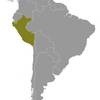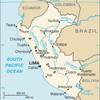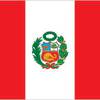Peru [+]Compare [E]dit [H]istory
Aliases: Republic of Peru, Republica del PeruObject «Peru» was created due to
Add new object to «Peru» or move existing objects here.
Object «Peru» has attributes [Show empty attributes][Hide empty attributes]
| Attribute | Value |
|---|---|
| Geography | |
| Area | 1,285,216 km² |
| Continent | South America |
| Land area | 1,279,996 km² |
| Water area | 5,220 km² |
| Land boundaries | 7,062 km |
| Border countries |
|
| Coastline | 2,414 km |
| Mean elevation | 1,555 m |
| Lowest point | 0 m |
| Highest point | 6,746 m |
| People | |
| Population | 31,914,989 |
| Official languages |
|
| Religion | Roman Catholic |
| Government | |
| Long country name | Republic of Peru |
| Short country name | Peru |
| Long local name | Republica del Peru |
| Short local name | Peru |
| Former name | Add |
| Government type | Presidential republic |
| Capital | Lima |
| Economy | |
| GDP (PPP) | 430,300,000,000 USD |
| GDP (OER) | 214,200,000,000 USD |
| GDP (real growth rate) | 2.5 % |
| GDP - per capita (PPP) | 13,500 USD |
| Gross national saving | 19.8 % of GDP |
| Labor force | 17,030,000 |
| Unemployment rate | 6.9 % |
| Population below poverty line | 22.7 % |
| Budget revenues | 58,060,000,000 USD |
| Budget expenditures | 64,810,000,000 USD |
| Military expenditures | 1.19 % of GDP |
| Taxes and other revenues | 27.1 % of GDP |
| Budget surplus or deficit | -3.1 % of GDP |
| Public debt | 25.4 % of GDP |
| Inflation rate | 2.8 % |
| Central bank discount rate | 4.25 % |
| Commercial bank prime lending rate | 16.6 % |
| Stock of narrow money | 33,410,000,000 USD |
| Stock of broad money | 33,410,000,000 USD |
| Stock of domestic credit | 56,700,000,000 USD |
| Market value of publicly traded shares | 56,560,000,000 USD |
| Current account balance | -2,414,000,000 USD |
| Exports | 44,920,000,000 USD |
| Imports | 38,650,000,000 USD |
| Reserves of foreign exchange and gold | 63,830,000,000 USD |
| External debt | 66,250,000,000 USD |
| National currency | nuevo sol |
| National currency (code) | PEN |
| National currency (symbol) | S/. |
| National currency rate to USD | 3.265 |
Ancient Peru was the seat of several prominent Andean civilizations, most notably that of the Incas whose empire was captured by Spanish conquistadors in 1533. Peru declared its independence in 1821, and remaining Spanish forces were defeated in 1824. After a dozen years of military rule, Peru returned to democratic leadership in 1980, but experienced economic problems and the growth of a violent insurgency. President Alberto FUJIMORI's election in 1990 ushered in a decade that saw a dramatic turnaround in the economy and significant progress in curtailing guerrilla activity. Nevertheless, the president's increasing reliance on authoritarian measures and an economic slump in the late 1990s generated mounting dissatisfaction with his regime, which led to his resignation in 2000. A caretaker government oversaw a new election in the spring of 2001, which installed Alejandro TOLEDO Manrique as the new head of government - Peru's first democratically elected president of indigenous ethnicity. The presidential election of 2006 saw the return of Alan GARCIA Perez who, after a disappointing presidential term from 1985 to 1990, oversaw a robust economic rebound. Former army officer Ollanta HUMALA Tasso was elected president in June 2011, and carried on the sound, market-oriented economic policies of the three preceding administrations. Poverty and unemployment levels have fallen dramatically in the last decade, and today Peru boasts one of the best performing economies in Latin America. Pedro Pablo KUCZYNSKI Godard won a very narrow presidential runoff election in June 2016. Facing impeachment after evidence surfaced of his involvement in a vote-buying scandal, President KUCZYNSKI offered his resignation on 21 March 2018. Two days later, First Vice President Martin Alberto VIZCARRA Cornejo was sworn in as president.
Similar objects
Most often compared with
Everyone can something to edit or add.
There were 2 edits, no edits waiting approval. Last edited by Guest_1196(-101), May 26, 2020 (48 fields were changed)
Help · Contact us · Disclaimer · Contributors · Developers · Donate


